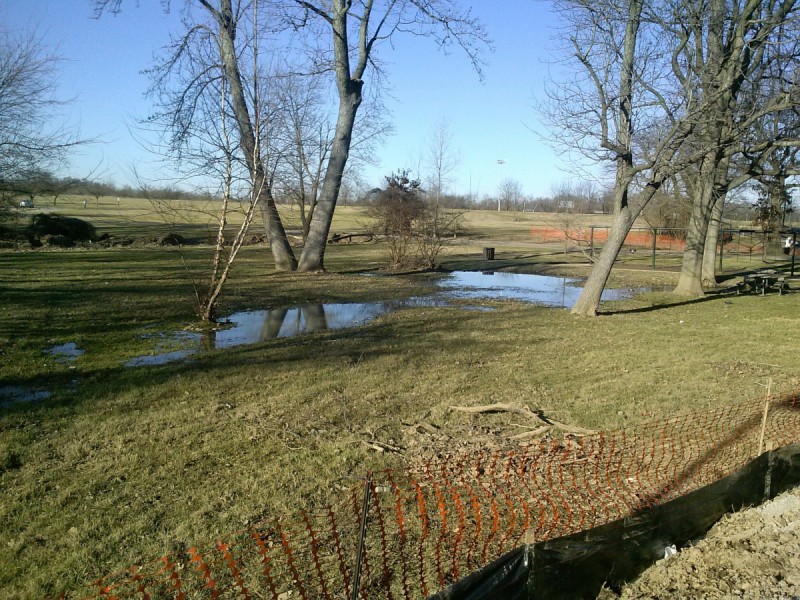The feds made Kenilworth Park a toxic waste site. Muriel Bowser wants to clean it up.

Image by the author.
What's now Kenilworth Park used to be the DC dump, and turning it into a real park would require a serious clean-up effort, and the federal government, which owns the land, hasn’t exactly been in a hurry to make that happen. But now Mayor Bowser wants to help move things along.
In the first part of the 20th century, the 700-acre Kenilworth Park consisted of woodlands and tidal marshes known for its waterfowl. However, in 1942 DC’s Congressionally-appointed government selected the park, which the National Park Service (NPS) owned, for use as the city dump.
The Kenilworth dump sites. Image by National Park Service.
For decades, trucks dumped garbage onto the banks of the Anacostia River, filling in the marshes. The park was used for open burning of trash until 1968 when Kelvin Tyrone Mock, a seven year old boy, was trapped and killed by the flames. NPS capped the landfill in the 1970s but did not use the water-impermeable soils necessary to permanently seal the pollution off from the environment.
Currently, the park is a vast area of crumbling sports fields and overgrown prairies that is isolated from the Ward 7 neighborhoods that sit right next to it. The new Anacostia River trail detours through those neighborhoods because DC’s transportation department didn't want to build on the park site site until it was remediated.
In 2006, Louisiana senator Mary Landrieu proposed and passed legislation that would transfer a portion of the site to the District. The District balked at the transfer due to the hefty remediation bill that came along with it, insisting NPS should clean the park up and then give it to DC.
The feds have talked about solving the problem for a long time
NPS started studying how to tackle the clean-up of Kenilworth Park in 2003, and in 2013 the agency issued a report that outlined a few options for approaching the issue: one was to do nothing; two were smaller efforts to keep groundwater from building up in contaminated soils or add more soil to further separate what was contaminated from the outside environment; and one was to spend somewhere between $400 million and $1 billion on excavating all of the hazardous waste and restoring the original tidal wetland habitats.
NPS wound up going with proposal three, which had an $18 million price tag. Even this more modest goal has been slowed because it’s been hard to get the funds needed to complete the currently underway groundwater contamination studies and carry out the eventual remediation of the site. NPS funds are limited in general, and under the current administration will only become moreso.
The National Park Service did recently publish the Anacostia Park Management Plan and Environmental Assessment. The plan aims make all of the National Park Service land on the eastern banks of the Anacostia River—it lumps Kenilworth Park into that— into a “signature urban park” by creating a new system of sports fields, nature trails, and cultural and educational programming.
Mayor Bowser wants to move the effort along
The mayor’s budget, which came out last week, puts $68 million towards the cleanup of the Anacostia River and the adjacent Kenilworth Park over the next five years, efforts that would augment— or stand in for— what NPS is trying to do.
The first step in DC’s process would be identifying, analyzing, and figuring out what to do with hazardous materials. That would be an important part of of making the Anacostia a fishable, swimmable river that is a resource to communities on both banks of the Anacostia.
As a Ward 7 resident (and someone who lives a block from this park) it's great to see the mayor make Kenilworth Park a priority. For nearly two decades since a NPS dumping scandal, Kenilworth Park has languished without much attention. The money in the budget is a substantial sum that can make a tremendous difference for DC’s environment and the communities in Ward 7.
The marshes at Kenilworth Aquatic Gardens show what Kenilworth Park used to look like. Image by Ron Cogswell licensed under Creative Commons._June_2013_800_228_90.jpg)
Also, this financial commitment could signal the beginning of improved collaboration between NPS and the District at Kenilworth Park. Although District residents might bristle at paying for a cleanup that should be the feds’ responsibility, it may be the most pragmatic way to right this decades-old wrong and revitalize a long neglected park. Given the current administration’s priorities, it is unlikely that the NPS will have the funds to do carry out a cleanup on its own anytime soon.
Cleaning up this site would create an opportunity to not only remove toxic pollution, but also create a world class amenity for the District. And without the clean-up, Kenilworth Park may remain a no man’s land where both DC and NPS are reluctant to commit resources.
Our park has tremendous potential as a waterfront, a regional destination for sports, activities and even as a home for wildlife.
